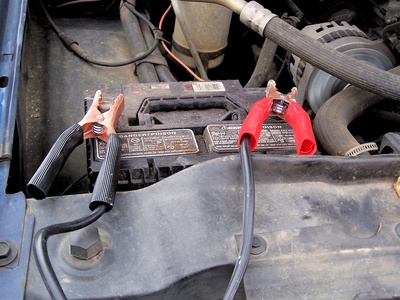
Jump-starting a car can be an extremely dangerous, albeit relatively basic maintenance procedure. Failure to jump start the car correctly can not only result in severe damage to the electrical system of one or both of the cars used in the jump-starting process, but it also can cause serious bodily harm to you. Safely jump-starting your car requires you to follow a meticulous procedure for attaching and detaching jumper cables and allowing both cars ample time to charge and recharge their batteries.
Position the cars so that the battery compartments of each respective vehicle are as close as possible. For example, if one car's battery is on the passenger side of the car, and the other's car's battery is on the driver's side, simply pull the car with the battery on the driver's side up next to the passenger side of the other car (or vice versa, depending on which car is dead). If the cars have the battery on the same side, you will need to park the cars in opposite directions, aligning the battery compartments up next to each other. The objective is to avoid draping wires over either car's engine compartment while jumping.
Pop the hoods of the cars.
Attach the negative (black) jumper cable clamps to the jumper cable itself. This will prevent the clamps from flapping around and potentially contacting the battery, a piece of metal or your skin.
Attach a positive (red) jumper cable clamp to the positive terminal on the car with the dead battery. This will be labeled with a "+" sign.
Connect other positive jumper cable clamp to the positive terminal on the car with the live battery.
Unclamp the negative (black) jumper cable clamp attached to the cable that is attached to the live battery, and connect that negative cable clamp to the negative terminal on the live battery.
Unclamp the negative jumper cable clamp attached to the cable that is attached to the dead battery and connect that negative cable clamp to a clean, unpainted metal surface somewhere under the hood of the dead battery, such as the engine block. This will ground the connection.
Start the car with the live battery, and allow it run for two to three minutes.
Start the car with the dead battery. Once the car with the dead battery starts, keep it running for at least 30 minutes to ensure that the engine's alternator is able to completely charge the dead battery.
Detach the cables in the reverse order, alternating from negative grounding cable from the engine block of the car with the dead battery, to the negative cable on the live battery to the positive cable on the live battery to the live cable on the dead battery.